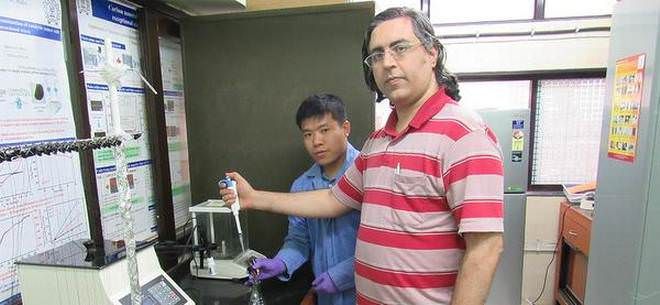IIT Bombay’s Very Low Power Water Filter
Published on by Water Network Research, Official research team of The Water Network in Academic
The water filter can desalinate water as it trickles down the electrodes by gravity
Unlike the conventionally used reverse osmosis which is energy-intensive, desalination of tap water to make it potable (less than 200 ppm of ions, which is the WHO standard) is now possible by using very low power.
By R. Prasad

The water filter can desalinate water as it trickles down the electrodes by gravity thus eliminating the need for any water pumping system.
The water filter developed by a two-member team led by Chandramouli Subramaniam from the Department of Chemistry at the Indian Institute of Technology (IIT) Bombay has a high desalination rate and capacity; one gram of electrode can remove 139 mg of salt (calcium, magnesium, sodium and potassium ions) at a rate of 3 mg of salt in one minute. The efficiency of ion removal is high at about 84%. The results were published in the journal ACS Applied Materials and Interfaces.
“Our electrodes have more than three times higher salt-removal capacity and two times higher salt-removal rate, which make them the best among all known materials, says Prof. Subramaniam. The researchers used a novel way to produce the electrodes which are used for capacitive deionisation to remove salt from water. Carbon nanotubes were synthesised and cellulose thread was dip coated with these nanotubes. The dried carbon nanotube thread was then closely wound across flat copper plates to produce the electrodes.
Synergy
While carbon nanotubes are hydrophobic in nature, cellulose thread is highly water-loving (hydrophilic). By combining the two the carbon nanotubes thread becomes hydrophilic — water shows initial contact angle of 63 degree which then reduces to 15 degree in 30 seconds contact time.
The highly hydrophilic and mesoporous nature of the thread combined with nano-sized pores and high surface area of nanotubes allow the ions to be effectively and quickly removed from water. “Achieving the right combination of surface area and porosity is critical to achieve this high performance,” says Prof. Subramaniam.
Two electrodes are placed one above the other and separated from each other by 2 mm. The water flows between the plates in a narrow channel of 60 mm length, 6 mm breadth and 2 mm height. “We have currently tested with flow rates of 6 ml per minute” he says. “The volume of water filtered can be scaled up by having a larger channel using longer and wider electrodes,” says Maku Moronshing from the Department of Chemistry at IIT Bombay and the first author of the paper.
Read full article: The Hindu
Media
Taxonomy
- Treatment
- Treatment Methods
- Drinking Water Treatment
- Filtration
- Filtration
- Desalination
- Drinking Water
- water treatment